THE OFFAL TRUTH
The Offal Truth
Once a staple of peasant cooking, variety meats are becoming the heart of high-end cuisine.
BY AMY ZAVATTO

COOKING IS AN ART FORM—and like some of history’s finest masterpieces, some of today’s most sought-after dishes incorporate seemingly unusable materials. What old newspapers and tires were to Robert Rauschenberg, jowls, en-trails and little piggy tails are to modern-day chefs.
But are these parts really what haute cuisine is made of? As a matter of fact, they are. Gone are the days when the word “sweetbread” incited a wrinkling of the nose, or eating a terrine made from a slow-simmered hog’s head was the feat of a culinary daredevil. Chefs across the country are boldly bringing the offal truth to fine-dining enthusiasts—and it appears they’re eating it up.
The word offal—or variety meats—actually comes from the simple but direct description “off-fall.” After an animal was butchered for all its choice skeletal-meat cuts, this was the stuff that was left over, or literally fell off.
“Right now, we’re going through anywhere from 50 to 75 pounds of pigs’ feet a week,” says Chef Chris Cosentino of San Francisco’s Incanto (www.incanto.biz; 415-641-4500), regarding his customers’ love of offal. “And nervetti [tendon] sells very well for us, too.”
For Cosentino and an army’s worth of other chefs around the country, using the entire animal is partly about respect and a desire to get away from wasteful decadence, and partly about the challenge, since it isn’t easy to turn innards into enticing dishes. One thing it’s not about: shock value. This might make for good episodes of “Fear Factor,” but even during the gross-out moments of “No Reservations,” Chef Anthony Bourdain has an admiration for food and the cultures that have long embraced the tenet of waste not, want not.
“Some of us refer to it as the Fifth Quarter,” says Chef Michael White of Convivio (www.convivionyc.com; 212-599-5045) and Alto (www.altorestaurant.com; 212-308-1099) in New York. White—whose practical Midwestern upbringing and seven-year cooking stint in Imola, Italy, greatly informs his nose-to-tail view of the culinary world—is fond of taking the food of the people to a higher level, serving slaved-over dishes like crostini of porchetta terrine made from slow-braised pig’s head, frito misto of calves brains (“They’re like cream puffs,” he says) and grilled, spiced lamb heart.
“It’s the kind of meat that the Romans were using after the wealthy people took away all the good stuff. They were left with the brains, the sweetbreads, the lungs, the spleen. It’s really the heart of Italian peasant cooking,” he says.
Actually, it’s the heart (and brains and kidney and thymus) of most peasant cooking. From fragrant, steaming bowls of Vietnamese pho, rich with beef tendon, to Southern American chitterlings (despite its cute-sounding name, it refers to pig intestine), the powerful farm-to-table movement has brought a variety of ethnic culinary traditions to the formerly squeamish, who are now clamoring for alternative cuts of cow, pig, lamb and even fish.
Ten or so years ago, you may have found the occasional sweetbreads and seared foie gras on a menu, but today, these items are as ubiquitous as steak, since demand and curiosity have grown like an overstuffed duck liver. Today, it’s dishes like Chef April Bloomfield’s cod milt (you don’t even want to know what this is) at New York’s The John Dory (www.thejohndory.com; 212-929-4948) that are winning critical raves.
“I think people have palate fatigue,” White says. “New Yorkers eat out every night. The people who are coming to my restaurant don’t cook at home; they’re foodies, devotees. Or they like to eat out a couple of days a week and cook at their own house the others. So they want to try things that they’re not apt to try on their own.”
But this trend isn’t limited to finicky New York gastronomes: Boston’s Eastern Standard (www.easternstandardboston.com; 617-532-9100) has a daily rotating offal menu, featuring dishes like lamb kidney stroganoff and seared veal liver over sunchoke purée with Vidalia onion rings, giving a whole new dimension to the blue plate special. Sweetbread and swiss chard risotto is served at Indianapolis’ L’Explorateur (www.dinelex.com; 317-726-6906), while Chef Jennifer Jasinski’s decadent seared rabbit loin with rabbit kidney mousse can be savored at Denver’s Rioja (www.riojadenver.com; 303-820-2282). And at the beloved little Zazu (www.zazurestaurant.com; 707-523-4814) in Santa Rosa, CA (55 miles from San Francisco), Chef John Stewart makes a pig heart sandwich with mustard-seed aioli that even managed to convert his formerly-vegetarian chef and wife Duskie Estes to an offal lover.
“You now have new flavors, new textures, new variation with the underlying flavor of that same animal,” Cosentino says. “It’s like a painter who just went from using five colors to 40.”
LAWFUL OFFAL
BEFORE YOU DIG IN, BE AWARE THAT SOME VARIETY MEATS ARE LEGALLY INEDIBLE.
While there is a veritable smorgasbord of offal from which to choose, some parts are deemed unfit for consumption by the Food Safety and Inspection Service, the public health wing of the USDA. The language can be tricky because, as FSIS public affairs representative Roger Sockman says, “Different cultures consume products that are not typically consumed by other cultures.”
Pigs’ feet, for example, are “generally” not edible, but because many cultures consider trotters to be downright delicious, you can find them for legal purchase in some stores or eateries. As a rule, however, Sockman notes that the following items generally are not considered edible: Hide or hair; hooves/feet; lungs; and spleen.
SPEAKING IN TONGUES
WHAT ARE LIGHTS? DON’T KNOW YOUR TROTTERS FROM YOUR GIBLETS?
HERE’S A HANDY GUIDE TO SOME VARIETY-MEAT MONIKERS YOU MAY BE LESS FAMILIAR WITH:
CAUL: The webby, fatty membrane around the stomach. Chefs generally take a cue from its original purpose and use it as a wrap or casing around other foods.
CHITTERLINGS: Also known as chitlins, these are the fatty small intestines of a pig and are very popular in deep Southern cooking.
GIBLETS: Remember mom’s Thanksgiving gravy? It got its great meat flavor from boiled, chopped up giblets—the heart, liver and, sometimes, gizzard of a bird.
HEAD CHEESE: Made from the slow, long braising of a pig’s head. After overnight cooking, the skin slides off and you are left with the various bits of meat and gelatinous residue. These are formed into a mold and usually served cold and sliced (and, no, there’s no actual cheese in it).
LIGHTS: For the haggis-loving public, this term means lung. In the US, though, the FDA outlawed serving lung to the public in 1972. However, some still try to slip it onto their menus.
SWEETBREADS: It is commonly thought that these tender nuggets are exclusively thymus glands in the neck, but the pancreas is another option.
TRIPE: Sponge-like in appearance, this is the stomach lining.
TROTTERS: As the name plainly suggests, feet.
]]>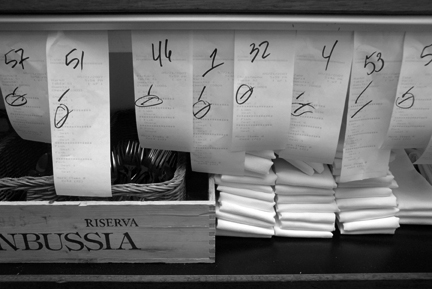
After much request I would like to introduce the winners essays. Enjoy them as much as I did, I look forward to spending more time with both of them in the kitchen.
Derek Dammann
Chef
DNA Restaurant
Montreal Canada
Good afternoon Chef, my name is Derek Dammann and I am chef of DNA restaurant in Montreal. I saw that you are offering an opportunity to stage for your annual Head to Tail dinner. I would like for you to consider me as a candidate. I admire your style of cooking and find that my approach is very similar in the way that you need to take a few steps back before you can move forward. Thinking in an old world way, and bringing back the artisinal traditions that have been forgotten. The “whole animal” philospohy is something that we practice at my restaurant as well. Using the entire animal, is both respectful to the beast, and exciting for us cooks. As well as having the opportunity to allow the customer to try somethings that they may never have had the chance to try before. I find that places with the approach that you have at Incanto offer a dining experience rather that a dinner out and I believe that is the direction that the food world is heading. Having a menu that is interesting, local, interactive and educational, that allows the guest to have fun and not just watch each other eat. That being said, I hope I get the chance to take part in this event. Best regards, Derek
Omar Rodriguez
Sous chef
Oyamel Cocina Mexicana
Comfort Food
Some of the fondest memories from my childhood were derived from my parents cooking. I remember standing next to my father on a hot south Texas summer night as he grilled fajitas, chicken and mollejas (sweet breads). As hungry as I would be for the mesquite grilled meat, the true reward for standing by my father’s side and waiting was getting the first hot off the grill pieces of mollejas. I remember taking a sizzling hot piece in my hand, blowing on it to cool it down and then crunching through the crisp mesquite smoked crust and into the warm juicy, buttery center. That was complete heaven for me.
The point I am trying to make with this story is that my childhood has been filled with offal eating. Growing up in a Mexican household meant eating many atypical dishes from most American households, especially offal. For me there are several offal that are comfort food, especially dishes like mollejas, lengua (beef tongue), menudo (tripe stew) and tacos de tripas (intestines).
Another favorite childhood dish was my mother’s lengua. She would place the lengua in the oven in the morning, and would not pull it out until she got back from work in the afternoon. I loved coming home from school those days and smelling the rich roasting beef scent permeating throughout the house. My mom would shred the lengua meat and stuff it into corn tortillas with shredded lettuce, chopped onions and my grandmother’s home-made salsa.
With the time I have spent in the culinary world I have had many opportunities to learn more about working with offal. Some knowledge has been passed on by other individuals or gained through my own research. I credit the book Charcuterie, as well as any one of Diana Kennedy’s books, as inspiration for many of my offal adventures. At Zaytinya in Washington, DC, I had the opportunity to work with Chef Mike Isabella. He demonstrated how to work with items like lamb tongue and brain. He also pushed me to pursue my love for charcuterie, which led me to create a merguez recipe for the restaurant. Last year I left Zaytinya and transferred to one of our sister restaurants Oyamel Cocina Mexicana. Under the tutelage of Chef Joe Raffa I have continued to pursue my love for offal and develop Mexican inspired offal dishes. I have been involved with creating an in-house chorizo recipe, lengua torta (beef tongue sandwich) and my favorite, queso de puerco (Mexican head cheese).
When I discovered Offal Good last year I was so excited that a chef had dedicated a restaurant towards the preparations of offal. It inspired me to experiment more with offal dishes at my restaurant and reconsider what can be cooked for dinner. There is still so much more to learn about offal cooking and I hope to continue to educate myself on the subject. I hope that part of this continuing education will involve the opportunity to assist you and your staff during Incanto’s annual Head to Tail dinner.
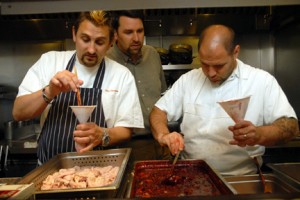
stuffing vesica
As promised today is the day for the stage winners to be announced. This was not an easy decision I reviewed and read over 25 essays and resumes for these 2 coveted spots. The applications came from all around the country it amazed me how many people wanted to travel for these work days here. But the info you have all been waiting for: Please pack your knives,
Omar Rodriguez
Washington, DC
Derek Dammann
Montreal, Canada
I look forward to having you both in my kitchen. If there are any questions please email me ASAP.
Thank you everyone for your essays and resumes I really appreciate all the effort and thought put into them. I wish i could have more people in the kitchen but there is only so much room.
]]>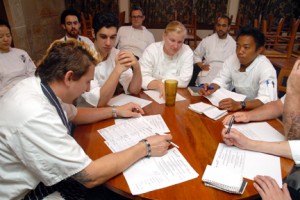
I have decided to do something a little different for this year’s head to tail dinner, inspired by the constant requests for knowledge about how to cook offal. Now’s your chance to learn. I will be accepting 2 volunteers to help with the event this year. You get to come into my kitchen and help cook 2 nights of head to tail dinners. You will work your ass off, have some fun and learn a ton, but there are rules to this game. This offer is open to professional cooks only. You will be an unpaid volunteer. You must commit to working in my kitchen for 5 days, from Friday, March 20th through Wednesday the 25th except for Tuesday, which you’ll have off to recover. You must submit your resume and a short essay on why you should be one of the chosen ones. This is a busy time and I don’t have time to be baby sitting. The Head to Tail dinner is a multi-course menu with a shit load of detailed work..
Here is the pay out; you get both of my t-shirts to take home and you will be able to sit down and enjoy the head to tail menu in the dinning room on the last night.
Email your resume and brief essay to me at [email protected] by next Wednesday, March 4th. I will make a final decision and contact the 2 lucky winners on March 6th to confim your participation. Ultimately, this is a fun opportunity to be a part of a great team for a week and learn how to cook some innards.
]]>The day I had surgery an 85lb pigs head was delivered to the restaurant. When I got the call the next day about this pigs head I was excited but bummed I couldn’t be there. So to make sure I was happy my Pastry Chef Thomas took great photos on the butchering and cooking process. I know you have seen how to butcher the pigs head from me in the past but I am really happy that my team nailed it with this pigs head.
Thanks guys you did a great job as always.
]]>
stuffing vesica
That time of the year has come again, the 6Th Annual head to Tail. This year we will be doing 2 days of this special menu featuring the wonderful parts of those animals that we all know and love. The menu is fun I have been planning and refining it since last year. I cant wait to see you all there.
For more information about booking a reservation go here. I have included the menu below.
6th Annual Head to Tail Dinner
Monday March 23 & Wednesday March 25, 2009
Note: menu subject to change depending upon availability.
Venison heart tartare, foie gras & ciccioli brioche
________________________
Goose intestines with fava beans & artichokes
________________________
Big brain, little brain with asparagus
________________________
Cordedda with peas, mint & sheep’s milk polenta
________________________
Coffee & Doughnuts: pork liver, blood, chocolate, espresso
* Optional wine pairings will be available by the glass or flight
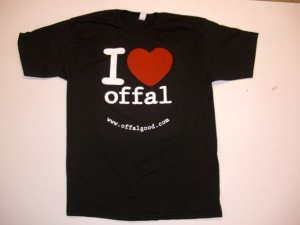
After multiple requests for a non profane T-Shirts. I have decided to do shirts modeled after the I love New York T-Shirts. Simple and straight to the point.
]]>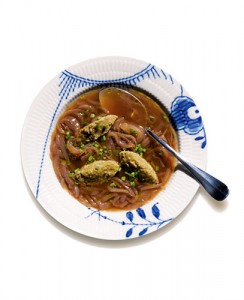
Click on the picture for the recipe to the redux dish.
Each week the New York Times magazine does a column called Recipe redux by Amanda Hesser. This Sunday they featured a recipe, ironically from one of my regular guests parents which was published in 1971. The concept is simple Take a previously printed recipe and give it to a chef to use for inspiration or to take and turn it into something totally new. This was fun and a cool learning experience, they even let me use offal.
Here is a link to the article: Recipe Redux New York Times Magazine
]]>This is a great video from Anthony Bourdain and No Reservations.
Again PETA is throwing money at the wrong thing offering someone the grand prize of $10,000 and their name for ever tied to this abomination vegetarian faux gras. Don’t get me wrong i love vegetables, but this is just to much. I have attached the rules and regulations to the contest, seeing as its such a great opportunity to stop such a tasty historical food from existing. So stay the fuck out of my stomach. Don’t worry folks the poor bastard who puts their name on this Faux Gras will go down in infamy.
Worldwide Challenge to Find the Perfect Humane Alternative to a Cruel Dish
For Immediate Release:
January 5, 2009
Contact:
Nicole Matthews 757-622-7382
The traditions of French food date back hundreds of years to a time long before legendary chef Georges Auguste Escoffier brought new life to the rich cuisine. Many of these recipes have long included ingredients that are obtained from animals. Many people, however, don’t eat these ingredients but still like to enjoy traditional dishes. And that’s exactly why we need you.
![]()
 Foie gras, French for “fatty liver,” is made from the enlarged livers of male ducks and geese.
Foie gras, French for “fatty liver,” is made from the enlarged livers of male ducks and geese.
Fine-dining patrons around the world have chosen to forgo real foie gras because of the cruelty to animals that results from force-feedings as well as the poor living conditions and environmental concerns that stem from foie gras production. And many restaurants have pulled the product from their menus entirely.
But just because gourmets choose to skip this “delicacy of despair” doesn’t mean they want to miss out on traditional French food. That’s why we are calling on chefs around the world to use their skills to create the first gourmet, purely vegetarian faux foie gras.
PETA is offering a $10,000 prize to the chef who is best at creating a purely vegetarian foie gras that is as close as possible in taste, texture, and form to real foie gras. The winning recipe must be featured on a fine-dining menu.
A judging panel chosen by PETA will assess the prepared recipes based on palatability as well as similarity in taste and texture to real foie gras. Submissions will receive scores on a scale of 0 to 10 (0 denoting an unpalatable item that tastes nothing like foie gras and 10 denoting a delicious item that is indistinguishable from foie gras).
All techniques are acceptable for creating the dish. It can come from a page of Larousse Gastronomique or from a page in the molecular gastronomy playbook of Grant Achatz and Wylie Dufresne. Anything goes as long as it’s 100 percent vegetarian.
And don’t forget to take credit for your delicious dish! Think “Waldorf Salad,” and name the recipe after yourself or your restaurant.
The grand prize of $10,000 will be awarded to one winner at an internationally publicized event, and two runners-up with the second- and third-highest scores will each receive $1,000 in kitchen equipment.
Read the complete rules and then submit your original recipe now